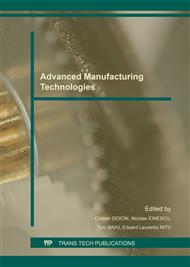p.79
p.84
p.90
p.96
p.102
p.108
p.114
p.120
p.126
Bore’s Surface Condition on Single Multifunctional Insert Tools Turning
Abstract:
Turning is a utilized machining work. It is performed with a large types of tools adapted for required geometries. If starting from a full blank, a drilling operation is called in the beginning. In that case, the number of utilized tools increased. The use of a multifunctional tool for drilling followed by bore turning is an efficient solution. In this research, the case of single insert multifunctional tool is studied. The paper describes the quality of the surfaces obtained by using of this tool. The general idea is to verify the use of only one multifunctional tool for execution of all operations, from full drilling to finished surface. This was made by measuring the roughness Ra in three experiments with different materials: titanium, stainless steel and low carbon steel. Performed experiments lead to the idea of a recommended limit for feed speed to obtain a roughness Ra value below 0.8μm. This limit depends with the material type, but for some materials, it seems impossible to achieve this value!
Info:
Periodical:
Pages:
102-107
Citation:
Online since:
April 2016
Authors:
Price:
Сopyright:
© 2016 Trans Tech Publications Ltd. All Rights Reserved
Share:
Citation:


